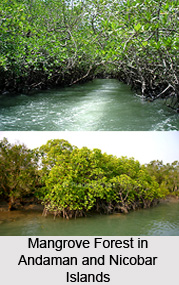 Mangroves of Andaman and Nicobar Islands encompass a vast expanse of about 966 square kilometres and comprises about one fifth of the total mangrove of India which constitutes 4827 square kilometres as per the Forest Survey of India. The area covered by mangroves in the Andaman districts is about 929 square kilometres whereas the Nicobar district has an area of 37 square kilometres under mangroves. It ranks third in terms of area of mangrove forest after West Bengal and Gujarat. However in terms of density and growth, mangroves of Andaman and Nicobar Islands are considered to be the best in the country. Around 9.4 percent of the total land area in the islands is under mangrove forest which constituted 10.85 percent of the total forest area.
Mangroves of Andaman and Nicobar Islands encompass a vast expanse of about 966 square kilometres and comprises about one fifth of the total mangrove of India which constitutes 4827 square kilometres as per the Forest Survey of India. The area covered by mangroves in the Andaman districts is about 929 square kilometres whereas the Nicobar district has an area of 37 square kilometres under mangroves. It ranks third in terms of area of mangrove forest after West Bengal and Gujarat. However in terms of density and growth, mangroves of Andaman and Nicobar Islands are considered to be the best in the country. Around 9.4 percent of the total land area in the islands is under mangrove forest which constituted 10.85 percent of the total forest area.
Features of Mangroves of Andaman and Nicobar Islands
Mangroves constitute salt tolerant forest ecosystem which grow mostly in tropical, sub tropical and inter-tidal regions. The vegetation includes trees and shrubs which thrive in brackish waters and muddy and shallow salt water usually along estuaries and quite shorelines. These are evergreen having thick leathery leaves which minimize transpiration. Root system of the plants is adapted to the peculiar conditions and is equipped with pneumatophores, knee roots and stilt roots. Viviparous germination is another significant feature of the mangroves.
Distribution of Mangroves of Andaman and Nicobar Islands
Mangroves of Andaman and Nicobar Islands mostly occur along the muddy shores, backwaters and fringing the creeks. The width of mangrove vegetation along the creeks ranges from 0.5 to 1 kilometre. Mangroves are salt tolerant community which are also found on rock shores and thrive on tidal action and regular deposits of mud. Shoal Bay in South Andaman, Austrin Creek in Mayabunder and Yerrata Jetty in Rangat of Middle Andamans are known for luxuriant mangroves.
Prominent Mangroves of Andaman and Nicobar Islands
Mangrove ecosystem of Andaman and Nicobar Islands constitutes about 27 tree species, 2 species of palms and ferns each belonging to 17 genera, 5 shrubs and 1 climber. Significant species found here include Nypa fruticans, Scyphiphora hydrophyllacea, Aegiceras corniculatum, Xylocarpus granatum, Exoecaria agallocha, Sonneratia caseolaris, Heritiera littoralis, Ceriops tagal, Avicennia officinalis, Bruguiera gymnorrhiza, Rhizophora mucronata and many more. Aegialitis rotundifolia, Bruguiera cylindrical, Kandelia candel and Aegiceras corniculatum are among the rare species found in the islands. Avicennia marina is also known as white mangrove owing to its smooth white bark.



















